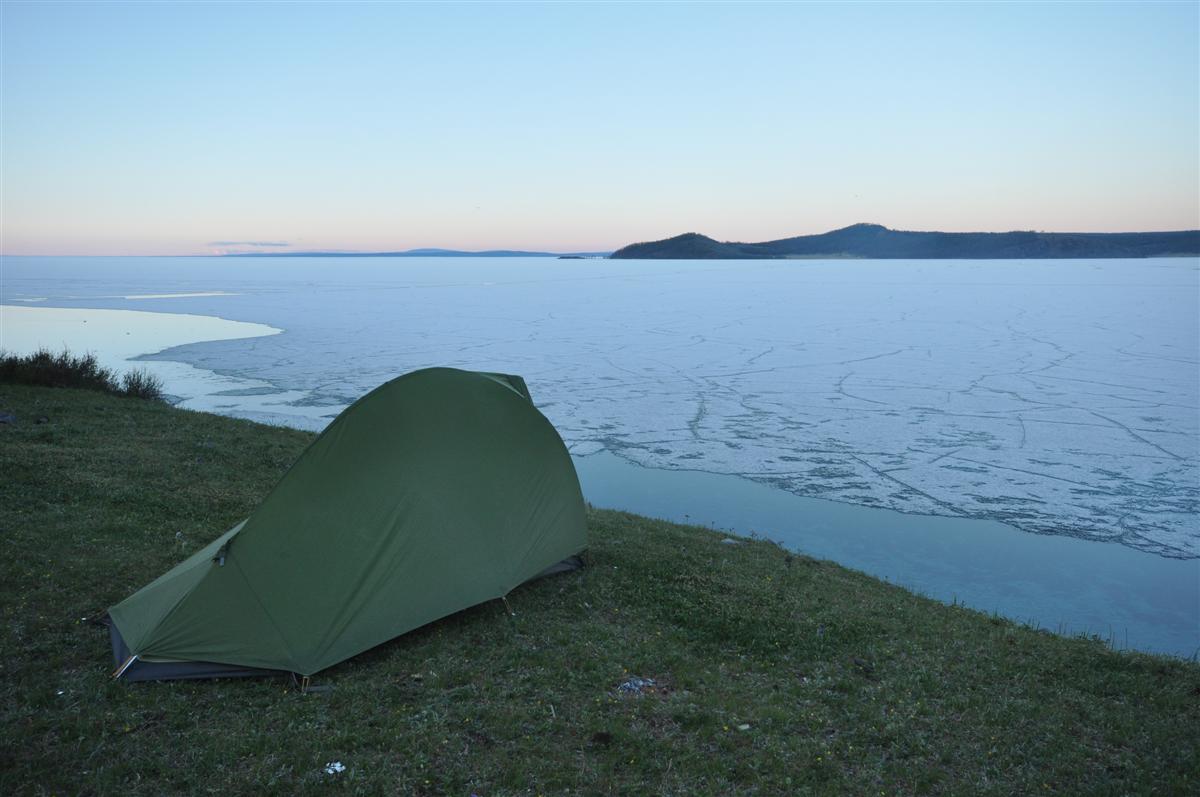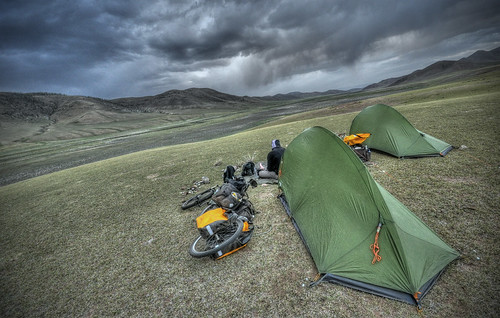This review was extensively rewritten in August 2012 with more photos and additional information on long-term performance over four years of real-world use.
My Vaude Hogan Ultralight 2‑man tent has performed almost flawlessly for four years of regular touring use between 2007 and 2011. The design is well suited to a solo cycle tourer or a very cosy couple, especially if you’re expecting harsh weather conditions. The tent does have a couple of minor drawbacks, which I’ll come to later.
Build Quality
As you would expect for a tent at this price point, build quality is very high, and the Vaude Hogan will withstand a lot of use in a wide variety of environments.
Importantly for a cycle tourist on the move, the Hogan doesn’t seem to suffer from being packed and stored in the short-term while wet, which some other manufacturers’ ultralight tents won’t withstand. On a tour in wet weather it’s often impractical or impossible to dry out a tent every day, and you don’t want to have to worry that the flysheet coating will disintegrate.
The v‑profile stakes are strong, but not the strongest. Make sure you plant them fully if possible, as otherwise you WILL tread on and consequently bend them in the dark and/or sleepy daze that you will inevitably find yourself in a some point. My experience with MSR’s stakes, for example, is noticeably better in terms of weight/strength ratio.
Performance
The inner tent is usable alone in warm weather, without the fly. The door is partly mesh for ventilation, but won’t compare to a full mesh inner in really hot weather.
The construction has enough protection for sub-zero temperatures, if you ever find yourself camping in such conditions. I’ve slept in the Hogan below –30°, although I’m not sure I’d recommend it.
It is a shame that the inner tent is not fully freestanding for pitches where stakes can’t easily be used, but there are always workarounds for this.
Water resistance is, as you’d expect from a European tent, top-notch. The tent hasn’t let a drop of water in during the worst rainstorms. It’s also robust enough to be assembled mid-downpour, as the inner tent has some short-term water-resistant properties. The flysheet sheds water very well and droplets bead off very quickly with a few shakes.
In high winds, the design’s storm-proofing measures become apparent. Pitching begins by planting the single peg at the foot of the tent, which should be facing upwind. (The separate groundsheet can be attached semi-permanently to the inner tent’s stake loops by velcro.) Once the inner is hooked to the rear peg, you can peg out the remaining corners and insert the poles, onto which the inner tent then clips.
The flysheet then attaches to the inner tent at the foot by means of a plastic locking connector, stable and secure in high wind. You can then simply clip the fly into the other connectors at the head of the pitched inner tent, before pegging out the sides and the porch. This can all be done by one person — with a bit of practice of course!
Extra measures for really heavy storms include internal velcro straps to secure the flysheet to the poles and 4 external guy-lines. It would take a hurricane to uproot the Vaude Hogan. As long as the tent is correctly oriented to the prevailing wind direction, its aerodynamic shape proves highly stable, and the downwind porch makes entering and exiting during a storm as comfortable as it’s ever going to be.
The porch also provides adjustable ventilation through a well-designed zip system which combines with the inner tent’s mesh door to provide whatever level of ventilation is appropriate for the conditions.
Size, Shape & Colour
The size is perfect for a solo cycle tourer — you have enough space for your panniers, clothes, books and yourself on the inside, and any excess baggage in the porch.
For two people, don’t expect to get more than valuables inside the tent as well as 2 humans, unless one or both of you are particularly short! This is where the relatively small porch might be a problem if you’re paranoid about security — you’ll probably have to leave some of your luggage outside, although I do this routinely and nothing has been pinched so far. (Besides, a potential thief is probably more interested in your bike, and you won’t be getting that inside the Hogan in a hurry.)
The shape of the tent is clearly oriented towards weatherproofing rather than maximum volume and comfort, and this makes the foot end of the tent rather cramped, as opposed to symmetrical tents like the MSR Hubba, which is designed more for livability than full-on stormproofing, and is perhaps a better choice if harsh weather is not likely to be a regular feature of your cycle tour.
The complete kit’s packed weight is low, but it’s a little higher than the manufacturers make out — a touch above 2kg by my scales. For a 2‑man tent, however, this is still well within the ‘ultralight’ category.
If you’re doing a lot of wild camping and want to be inconspicuous, the colour of the flysheet is about as perfect as you will ever find on the market. The shade of green chosen by Vaude for the Hogan Ultralight, and others in the range, is a fantastically natural one, which really does blend in. (They also have an orange version. Don’t get that.)
Longevity
I use my gear until it’s well and truly worn out.
This being an ultralight tent, the materials simply aren’t going to be as durable in the long-term as heavier-duty tents. It’s useful to know what’s likely to break, and how to patch it up, so I include this information for that reason.
The poles snapped at the joints in the third year of use, while pitching during a storm in Mongolia. Vaude know that the ultralight aluminium poles eventually fatigue and therefore have a limited life, so they supply a repair sleeve which can splint a broken joint in an emergency. With a little Gaffa Tape, this worked very well and I was able to complete my trip.
The taped seams in the corners of the groundsheet split through age and repeated packing, and some of the flysheet’s seams started to leak. A small tube of Aquaseal can be used for repairs like this, or (again) the ever-trusty Gaffa Tape.
The zips suffered in the dusty deserts of Africa and the sliders wore out, no longer closing the coil. I fixed this in the short term by compressing the sliders gently with a pair of pliers. A bar of hand soap run along the (cleaned) coil helped to lubricate the zipper until I had the chance to return the inner tent to Vaude for a new zip to be sewn in.
By this time, the flysheet had also shrunk a little through UV exposure, making pegging the sides out quite difficult in loose ground. This was rarely an issue, as the tent is perfectly stable without the intermediate pegs along the sides. In rain, when it becomes more important to keep the fly separated from the inner, the usual trick of tying or bungeeing the stake loops to heavy objects is an easy workaround, in lieu of replacing the complete flysheet.
I retired my Hogan in its fourth year of use, as the built-in floor material had lost its waterproof qualities through sheer use. I cut a temporary new floor from a cheap plastic tarpaulin, but really it was time to replace the tent entirely, rather than extending its long list of repairs.
None of this should detract you from considering the tent — there are few ultralight tents that wouldn’t suffer similarly after this much use.
Conclusion
This would be an ideal tent for a solo tourer on a tour likely to involve challenging weather conditions, including high winds and plenty of rain. It would sleep two if needed, but with little comfort, and so I would only consider it a two-person option for shorter trips or if weight was at a real premium. If weather is less likely to be a concern, there are more livable tents on the market at a similar weight, price-point and quality. But overall this is a well-designed and very capable tent, which I was happy to call home for many years.









Something to add?